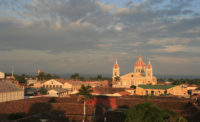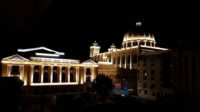In presenting their work, a number of speakers at the ninth Mundaneum conference on architecture charted personal journeys of finding their professional voices. These tales included moments of doubt and self-criticism, along with humor and discovery. The event—organized by Fund_ARQ, the Costa Rican Foundation for Design, Art, and Architecture, in collaboration with the Nicaraguan design magazine Estudio 505—brought speakers from Latin America, the United States, Europe, and Australia to Managua, Nicaragua, to address an audience of students, architects, and people interested in the built environment. Titled “Essential Architecture,” it continued the series of conferences that Fund_ARQ founders Alvaro Rojas and Guillermo Honles had run originally at the Universidad del Diseño in Costa Rica, the architecture school Rojas established in 1993 and closed in 2009.
Phil Harris, a partner at Troppo Architects in Adelaide, Australia, started off his talk with photos of the road trip he and a few university mates took in the late 1970s from the south of the continent to Darwin in the north. The shaggy-haired friends drove more than 1,600 miles in a Volkswagen van and researched tropical housing in Australia’s so-called Top End. Then, Harris and Adrian Welke established Troppo in Darwin. They named one of their first houses the Green Can, because its corrugated-iron roof reminded them of the container for their favorite beer. As many journeys do, Harris’s has come full circle with him back in the south of Australia, where he runs the firm’s Adelaide office.
Panamanian architect Patrick Dillon travelled a different path—from his hometown of Gamboa in the Canal Zone to Arizona State and Rice universities, then to Ricardo Bofill’s office in Barcelona, his own firm in Paris, and finally back to Panama. “I went from the jungle to the desert,” he said, talking about his early move to Arizona. During his years abroad, he worked on projects in Iraq, Algeria, and South Africa, and eventually became disillusioned with his profession. When he returned to Panama, he gave up architecture to work for his family’s construction company, mostly on infrastructure projects. But he kept seeing architecture in everything, such as the way an oil refinery’s steel framework created a play of light and shadow. Eventually, his love of architecture returned and he set up his own practice. He served as the executive architect for Frank Gehry’s Biomuseo in Panama City and has designed climatically responsive projects such as a simple shelter for himself in Veraguas, made entirely of salvaged materials. Called the SaLo House, it’s an off-the-grid structure with a great view of the Pacific Ocean and functions as a cherished retreat for the architect.
Like Dillon, Rojas left Central America and eventually returned. Educated at CCNY/City University of New York, Rojas stayed in New York to practice and teach. In his talk, he showed some images of an early project he did in Costa Rica, an office building with a large skylight over an atrium. With self-deprecating wit and a wisdom gained over the years, he admitted the generous skylight was a bad idea in the tropics. “I created a problem, then had to develop a solution for it.” Since that early mistake, Rojas has dedicated himself to sustainable design and educating the next generation of architects. He sees architecture as “a way of connecting with society,” and recently completed a community center for El Rodeo, a poor rural town in the Central Valley of Costa Rica.
Although he has practiced in San Francisco since the late 1970s, Stanley Saitowitz was raised and earned his first architecture degree in South Africa. In the United States, he has methodically developed a body of work in which each project refines and builds upon the previous ones. “I’ve emphasized evolution and continuity rather than uniqueness and re-invention,” he said. “Man’s greatest achievement has been in creating cities where each piece adds to the whole.”
Cazu Zegers from Santiago, Chile, began her presentation by talking about the dress she was wearing—a cream-colored cotton wrap with a shawl-like collar. Designed by a friend she has known since high school, it was made from a single bolt of cloth and fitted to her body. Her own work is much the same: simple, elegant, and comfortable. “My architecture is all about the relationship between the human body and nature,” she stated. “In Latin America, our monuments are found in nature.” She explained that the mixing of European and indigenous cultures informs so much of what gets built. “We’re all mestizo, we’re a blend.”
Educated in Germany, Thomas Spiegelhalter has spent most of the last two decades teaching in the United States—at USC, Minnesota, Carnegie Mellon, and currently at Florida International University. Teaching and practicing “provides a continual feedback loop with one reinforcing and informing the other,” he said. He has written books on sustainability and parametric design and is currently researching the way industrial enterprises such as automobile companies are developing self-learning robots that get better at what they do the more they do it.
The final speaker at the conference, James Wines, talked about the path that has taken him from sculpture to architecture. “The gap between art and architecture is a big problem,” he stated and then explained how his firm, SITE, has tried to bridge that divide. He encouraged students in the audience to challenge accepted wisdom and strike out in new directions. “An idea that is not dangerous is unworthy of being called an idea,” he said, quoting Oscar Wilde. Then he quoted Pablo Picasso: “You don’t make art out of the Parthenon. You make it from the debris at your feet.” Wines explained how most architecture is about form, space, and structure, but SITE deals with ideas and context. He extorted the audience to “expand the definition of architecture” and not just “milking” Modernism for another hundred years.









Post a comment to this article
Report Abusive Comment